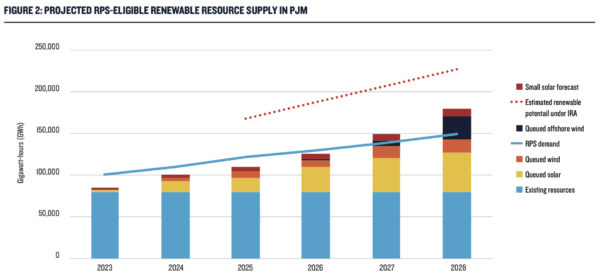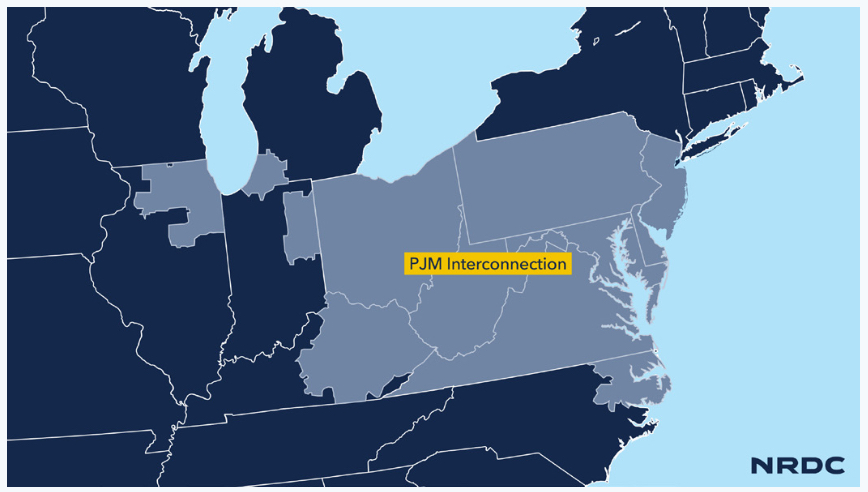The backlogged interconnection process of grid operator PJM Interconnection will enable construction of “just barely enough renewable energy” to meet the renewable portfolio standards (RPS) targets of states in the PJM region through 2027, the environmental group National Resources Defense Council (NRDC) projects in a report, as shown in the bar chart below.
PJM’s process will not meet the potential for renewable energy growth “fueled” by the Inflation Reduction Act (IRA) through 2028, the report says, as shown in the dotted line near the top of the bar chart. The report used a projection from the Princeton ZERO Lab that PJM will see an additional 1 GW of renewable energy projects enter the queue annually.

NRDC’s report considered a portion of the 13-state region served by PJM, consisting of 8 states plus the District of Columbia that have both a renewable portfolio standard (RPS) and much or all of their load served by PJM. The analysis used data on annual aggregate RPS demand from Bloomberg NEF.
For the portion of PJM evaluated, NRDC projected that 15 GW of new utility-scale solar will enter commercial operation by 2028, and used a value from IHS Markit that 6 GW of new small-scale solar will be added by 2028.
“States throughout PJM set ambitious RPS goals to cut emissions, lower costs, and boost reliability, but years of delays at PJM threaten to derail these plans,” said the report’s lead author Dana Ammann, an NRDC policy analyst.
“Our analysis represents the best-case scenario,” the report notes, pointing to three factors. The report highlights a “likely onslaught” of interconnection requests that PJM will face in 2026 when it begins to process interconnection requests submitted since October 2021; the potential for “RPS expansion and policy updates” across the states; and the investment uncertainty and “skyrocketing costs” faced by solar and wind developers, which could lead to projects being delayed or not completed, or being unable to take advantage of IRA incentives.
Tom Rutigliano, senior advocate with NRDC’s Sustainable FERC Project, said in an emailed statement, “We’re happy to see that PJM has started work to streamline transferring interconnections from retiring fossil fuel plants to new clean energy. PJM also needs to identify near-term transmission upgrades that will enable states’ clean energy goals, and work with states to find ways to get those projects funded and built.”
“Looking to the late 2020s and 2030s,” Rutigliano added, “PJM’s transmission planning needs fundamental reform. PJM currently plans for a future that looks much like the past, a recipe for failure as we move through the energy transition. PJM must update its planning to be based on realistic scenarios for the future energy mix and explicitly support state policies.”
All 13 states in the PJM region called for the grid operator to make faster progress on interconnection, in comments submitted last year by the Organization of PJM States, Inc. to the Federal Energy Regulatory Commission (FERC).
“The challenges faced by grid operators were not entirely unanticipated,” the NRDC report states. Quoting a 2008 white paper from the ISO/RTO Council, the report says the paper “recognized the impending challenges of an ‘overwhelming increase in new generation interconnection requests’ from public policies encouraging new renewable resources.”
NRDC’s report, titled “Waiting Game: How the Interconnection Queue Threatens Renewable Development in PJM,” includes state-level analyses for the 8 states plus the District of Columbia that were evaluated.
This content is protected by copyright and may not be reused. If you want to cooperate with us and would like to reuse some of our content, please contact: editors@pv-magazine.com.








By submitting this form you agree to pv magazine using your data for the purposes of publishing your comment.
Your personal data will only be disclosed or otherwise transmitted to third parties for the purposes of spam filtering or if this is necessary for technical maintenance of the website. Any other transfer to third parties will not take place unless this is justified on the basis of applicable data protection regulations or if pv magazine is legally obliged to do so.
You may revoke this consent at any time with effect for the future, in which case your personal data will be deleted immediately. Otherwise, your data will be deleted if pv magazine has processed your request or the purpose of data storage is fulfilled.
Further information on data privacy can be found in our Data Protection Policy.